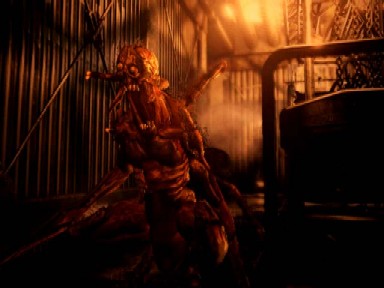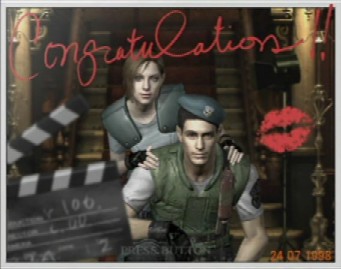
How Horrific
What does it mean to be a woman who kicks ass? Does that necessitate a fictionalized character or can any woman kick ass? Perhaps some women could use a bit of help in that area. This is where the female game character enters. The bond between player and character is bound to intensify, especially in highly tense situations such as that of the survival horror genre.
Introduction
Frankly, I've never appreciated the logic that follows statements that games, like golf, are a boys-only domain. Perhaps this has to do with the fact that I enjoy many supposedly "masculine" games and genres just as much as the next guy or girl for that matter. The idea that the gaming experience can be separated by sex is stifling and excludes a growing number of female and male gamers. It seems that the more important issue is not necessarily who is playing what games, but why they play them and what they get out of them. I'd like to look at games in the survival horror category (e.g. Resident Evil) particularly for their use of female lead characters in what is a violent, gory fright fest. What types of pleasures does the normative male gamer get out of playing as the gorgeous babe that just so happens to kick ass? Do strong female characters in games typically typed as masculine help make way for female gamers? In this essay I plan on joining the efforts of game theory with recent feminist/queer theory investigating the role of gender in horror films to illuminate the modes of identification in games like Resident Evil. By focusing on the fusion of the player and character into a merged cybernetic subject, I hope to show that the female leads in the survival horror genre serve as exceptional portals for the immersive gaming experience.
I find myself drawn to characters that aren't necessarily superhuman, but stand outside of normality's ideas about the ideal. So I root for the geek, the underdog, the oppressed and the girl. Girls are not taken seriously in our society, which creates the longing to be recognized. At the same time, this makes girl characters highly recognizable since they are ordinary but unique, matching the average-ness of the gamer. For example, one of my personal favorite kick ass women, Sydney Bristow, while not saving the world with the CIA can be seen hanging out with her friends eating ice cream and talking about movies. It is much harder to picture James Bond or Indiana Jones participating in such everyday affairs. There's something intriguing and entertaining about witnessing average individuals excel in the face of outrageous odds, tangled webs of international espionage or hordes of the evil undead. These off-type characters are more available to the viewer, but female characters have their own benefits in terms of providing access to alternative modes of participation.


Film Theory Meets Video Games
Film theory has quite a bit to contribute to the discourse involving female vehicles of connection and identification between the screen and the spectator. Even the horror and science fiction genres, traditionally off-limits to women and feminist/queer friendly readings, are rife with possibility for female and queer spectatorship. It would seem it only requires some extra effort to push an against the grain reading. There's opportunity to embellish the queasy and frightful feelings as well as relish in the power and triumph of the kill and survival of the fitful female character. These women go beyond just a pretty face and take on characteristics of the heroine while maintaining a certain amount of reachability to the spectator. For example, Sigourney Weaver's character Ripley of the Aliens series against all science fiction expectations,
she steps up and rather than cry 'Eek!' and freeze in the face of danger, Ripley becomes the dragon slayer who blows the beast into the vacuum of space (Doherty 194)
. In the midst of the horror of being hunted by aliens, vampires, zombies and other things that go bump in the night, women like Ripley let us feel the fear we may not normally open ourselves to and push us to be powerful as she/he/we run, scream, fall and fight.
Today's spectator is well versed in many textual languages and carries with them a storehouse of trivia, pop references and cultural capitol. Audiences are prepared to absorb all that the media has to give them, and this has resulted in alternative narratives, genre blending and enriched characters.
Television spawned a generation of genre-wise (and genre-surfeited) spectators, trained experts in the tropes, conventions and twists of formula programming. Having logged thousands of video hours in front of the small screen before adolescent passage into R-rated theatrical cinema, schooled in the lexicon of genre, zapping between narrative realms, television-age spectators of motion pictures can readily digest several genre menus at a single sitting (Doherty 189).
Genre aware and ready for consumption, audiences are beginning to experience narratives across forms and medias. Most recently, The Matrix Reloaded was released along with an anime feature and a game as integral to the full experience as the movie itself. Video games are coming into the limelight as they outsell Hollywood and continually borrow, augment and innovate its forms and conventions. Unlike the abstract games of 30 years ago, the video game industry has boomed past its days of black and white and into a golden age. In part, due to the large amount of narrative and generic crossover, it may prove interesting to apply some of these theories of spectatorship to video games in the hopes of claiming a space for alternative gaming audiences.

Carol Clover laid the groundwork for gender analysis of the modern horror film with her essay, "Her Body, Himself," by figuring the central female character, the Final Girl, at the center of a battle for male versus female versus transgendered spectatorship. The fear we experience is played out through the screams and missteps of the victims, the majority of which are female. There exists at least one female character that unlike her counterparts perceives the full extent of the preceding horror and of her own peril (Clover 35)
. The main characters in the Resident Evil series, Final Girls in their own right, enter the narrative at a point where all hell has broken loose and their now undead companions stumble slowly after them. Characters like Jill Valentine and Rebecca Chambers can't let their human attachments or relationships get in the way of their judgment. In the course of the game, they must untangle conspiracies, dispatch of the undead, survive betrayals and navigate through an atmosphere of mistrust. The classic investigating gaze of film theory in the case of the modern horror becomes unsettled in the slasher film
and likewise the survival horror video game as the active female reverses the look, making a spectacle of the killer and a spectator of herself (Clover 60)
. The story is motivated and told through the active eyes of the female character and it is this role that the spectator/gamer sinks into identification. The female character, Clover's Final Girl, works as both a masculinized and feminized point of identification for the spectator/gamer. It works out that the same female body [works] for both. The Final Girl 1) undergoes agonizing trials and 2) virtually or actually destroys the antagonist and saves herself (Clover 59)
.
Why is She Important?
These women are more than eyecandy; indeed they are your only ticket through the darkness alive. The atmosphere of the horror film and the horror game, engulf us whole into their world and tie us to these female characters. In the horror film male figures of identification are either absent or quickly dispatched while in games like Resident Evil it's not the sex that matters so much as which is the active character. Within the narrative of Resident Evil, with the exception of Resident Evil Zero where the player can instantly switch between characters, the gamer carries out the role of one character to the end. In effect both partners, male and female, enact the Final Girl's mixed gender roles (fear and strength) and the gamer has their choice.

Choosing the female character offers the same possibilities for trans-gender identification as articulated in the horror film. For the male gamer, playing as a female character offers the opportunity to connect on a level where sex is unimportant and all that matters is forming the bond of the player-character that will get them through. Female gamers are more than likely well versed in cross identifying and reading against the grain. However, when offered the chance to team up with a female player-character they can appreciate the image while exercising, perhaps with more relish, the strength and power of a strong female role. The idea that appearance and behavior do not necessarily indicate sex-indeed, can misindicate sex-is predicated on the understanding that sex is one thing and gender another; in practice that sex is life, a less-than-interesting given, but gender is theater (Clover 58)
. As sex begins to matter less, and even gendered roles of butch, femme, victim, attacker, and protector also wither, what takes its place are the common tropes and rewards that enrich any gamer regardless of sex or gender identity.
As our society is becoming a freer place to express our various identities and the MTV generation reaches the next step in gender fluidity, popular media representations will follow and reflect those freedoms (with some caveats). It is the playground of the horror to skew the norm and toy with the abject and taboo, which allows the genre to act out its game of gender, and sexuality (occasionally race also gets to party too). Survival horror games such as Resident Evil appear to take things a step further by setting the powerful female role to compete on even ground with an equally matched male counterpart. This causes a shift from the passive identification in the horror film to a conscious and active subject choice in the horror game. The choice is now present and everyone has something to learn from it. Girls who kick ass are more than the latest trend, but a sign that the strict policing of gender roles is crumbling. Boys are discovering women they can identify with and aspire to be like without fear that they are crossing the arbitrary lines between feminine and masculine. Even without the girl power, the presence of female characters can only be beneficial from the critical viewpoint/resistance of blurring gender and exploring alternative/resistive spectatorships.
